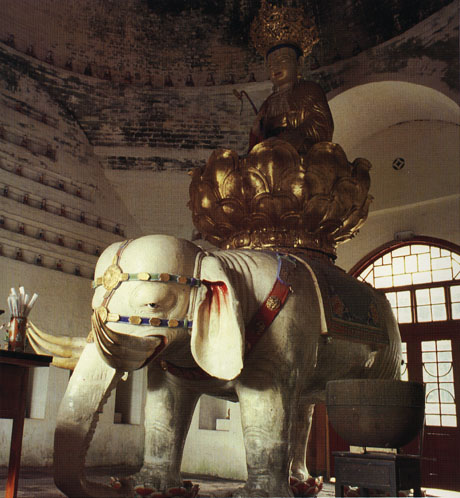|
Mount Emei belongs to the Qionglai Mountains in southwestern Sichuan Basin and is located in the Emei County of Sichuan Province. It consists of four major mountains -- Da'e (#1), Er'e (#2), San'e (#3) and Si'e (#4). Mount Emei mainly refers to the Da'e Mountain. From a distance, the Da'e and Er'e mountains look like a moth's pair of brows (antennas) that extend long, slender and curved in a picturesque fashion, the so-called "broad forehead, delicate eyebrows" (a popular saying in ancient China of describing a beautiful woman) hence the name of the mountain Emei which literally means "moth's brows", or "delicate eyebrows", just as the classic "Commentary on the Waterways" puts it, "On a fine autumn day, the two mountains stand opposite each other like a moth's brows".

Samantabhadra is one of the 4 major Bodhisattvas in Buddhism. According to the Avatamsaka Sutra (the Garland Sutra, meaning Flower Adornment Sutra), Samantabhadra expressed the cherished wish to disseminate the doctrines of the Buddha and was nicknamed "Samantabhadra the Tireless Traveller". He stood in attendance at Sakyamuni's (i.e. the Buddha's) right side and was in charge of benevolence, while Manjusri stood to the Buddha's left as the Bodhisattva in charge of wisdom. Since Samantabhadra was in the habit of reading and observing nature on the road, he needed a mount that could walk as smoothly as possible. That is why he was fond of riding his white elephant with 6 tusks. So in the Buddhist art, he is often shown as holding a double curved sceptre in his hand and sitting on a lotus seat fastened to the back of his elephant. That Mount Emei had become his bodhimandala had something to do with the natural light on the top of the mountain. It was said that when Pu Gong, a hermit of the Eastern Han Dynasty spotted the spectacular rays on the mountaintop, he consulted an Indian monk who had just arrived in China, who said,"This is the auspicious symbol of Samantabhadra. This light was originally used to protect Tathagata, but now it has made it's presence felt in this place for the benefit of the multitude." Such explanation was in accordance with the description of Samantabhadra's residence in the Garland Sutra, which says, " There is a Mountain of Brightness in the Southwest, where quite a few Bodhisattvas have resided since ancient times. The current Bodhisattva living there is Samantabhadra together with 3,000 family members. He often preaches the doctrines there." As the Garland Sutra was spread into China during the Eastern Jin Dynasty, Buddhists at that time began to worship Mount Emei as Samantabhadra's residence and bodhimandala. This tradition was handed down till this day.
The woodcarvings of figurines, flowers and birds in Tripitaka Pavilion are regarded as superb works of art. The Baoguo Temple is full of cultural artifacts. The display room in the Mahavira Hall features works of such celebrated Chinese calligraphers and painters as Zhao Mengfu, Xu Beihong, Qi Baishi and Zhang Daqian. Hanging on two walls in the Hall of Seven Buddhas are four wooden plaques inscribed with the "Hymns on Seven Buddhas" in the handwriting of Huang Tianjian, a famed figure of letter and calligrapher of the Song Dynasty. In the rear of the hall stands a 2.74-meter high porcelain statue of the Buddha, done in graceful lines and well-proportioned configuration, portraying the Buddha as a robust, sedate man wearing a thousand-Buddha lotus robe. Made in a porcelain-making kiln at Jingdezhen of Jiangxi Province in 1415, the 13th year of the Yongle reign of Ming Dynasty, it is considered as the best of kiln-made porcelain statue of the Buddha in existence. The Ming-dynasty lotus-flower bronze bell hanging in a bell pavilion atop a tiny mountain opposite the Bauguo Temple was 2.8-meter tall and weighs 12,500-kilograms, usually extolled as the "King of Bells of the Land of Abundance". In the Tripitaka Pavilion of the temple, there are many Buddhist classics, including a huge scroll inscribed with the text of "Wang Youjun's Preface to the Orchid Pavilion Collection of Poetry" in the handwriting of Zhao Mengfu, and works of famous calligraphers of various dynasties. The Ming Dynasty beamless brick hall of the Wannian Temple is known to have the best of all brick-and-masonry structures of Mount Emei. Enshrined in the immense space of the brick hall of the Wannian Temple is a bronze statue of Samantabhadra, riding his white elephant. This statue stands 7.35-meter high and weighs 62 tons. For its exquisite craftsmanship, the statue has been put under protection as a key cultural relic of national calibre.
If Mount Wutai is a cradle of Buddhist culture, then Mount Emei is a symbol of the ideals of Buddhism. The streams at the foot of the mountain, limpid and free from the dust and dun of the mundane world, give people a soul-cleansing effect. The craggy cliffs, deep valleys, dense woods and exuberant flowers are providing the visitors with a soothing experience. Mount Emei is a classical product of both nature and Buddhist culture and a perfect example of the harmonious relationship between nature and man seeking to return to the embrace of nature. |